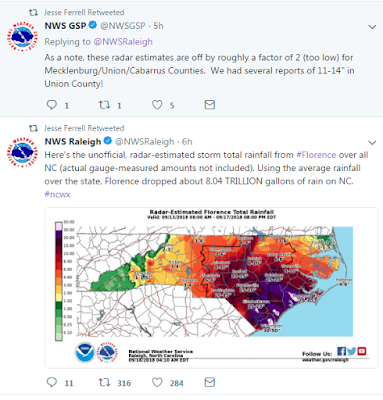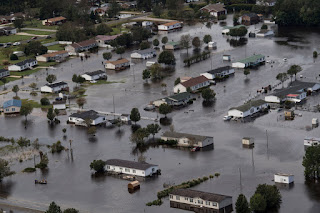9-10 Fun day. Watched a cat two storm this morning go to a cat 4 storm in the afternoon
Odd thing is no real changes. Arrival time is Thursday late afternoon or overnight. Target area is still Wilmington to Diamond Shoals. Models have moved around somewhat, but nothing to make me change my mind.
This storm will be dangerous. I question if the operational models (GFS, Euro, CMC, UKMET) really grasp the strength. Euro, for example, has landfall at 77mph. Its peak wind speed on the way to the coast is 91mph. Its 140mph now. Here are some other comparisons
For the record....
-
12z GFS has the pressure at 0z (8pm edt) at 955
-
12z FV3 has the pressure at 0z at 961
-
12z cmc has it at 992
-
NavGem at 996
-
Icon at 982
-
JMA is at 1002 tomorrow morning
-
UKMet I don't have updated for some reason. If anyone has it for 0z from the 12z run let me know
-
Euro at 974
-
HWRF at 0z is 942
-
HMON is 946
-
NAM32k is 971
Pressure at 8pm was 943mb.
This makes me want to consider the HMON and HWRF, both of which hit the targeted areas. HWRF is really bad coming close to landfall with 122kt winds (about 140mph). HMON is more reasonable at 100kts (115mph)
GFS is still goofy with it not making landfall, stalling, looping and gaining strength even though its churned up all the warm water. Then it loops SW and makes landfall. I'm ignoring the GFS once that happens - so I'll consider the track up to the stall and loops.
I do expect the storm to slow or stall once landfall occurs, but not out at sea. The details as to what happens after landfall still need to be worked out. There should be massive flooding. I like where the rain is on the Euro, I just think it may be almost double what it says. Yes, up to 30" over interior NC and/or VA. We'll figure out the stall tomorrow or wednesday.
I found this picture to be a good summary of the tracks.
http://www.atmos.albany.edu/facstaff/tang/tcguidance/al062018/
9-9 night
Well, we've reached the point where we're looking at a landfall that's
96 hrs or so away. 4 days. Model guidance is remarkably consensual.
You've got the CMC, NAVGEM, Ukie, Euro, AVN (GFS), two hurricane models
(HMON, HWRF) and even the NAM showing hits on or near NC. I don't
remember seeing this far out such consensus.
Even the NHC hurricane
models are remarkably, eerily, similar.
Which begs the question - what can go wrong?
We know there's not much in the way of steering currents once it gets this far, so there's that randomness at play
We know there's warm water. We know there's supposed to be little
shear. So intensification is likely. But how much? Is there an ERC?
There is a random trough out there (c) which may mess things a little,
but its fairly weak. As well as an upper low (D). Those are supposed to
disappear.
There's two systems down stream which could push back further. A&B
There's the H near Cuba (E) which could erode some and have Flo drop down, or push up some.
There's the stationary front we are currently dealing with (F) - does
it push south more, retreat further west or just dissipate.
 |
| 9-9 10pm water vapor |
Then there's the future - does that Atlantic Upper High (A) build and or orient as expected and then slide under. Do the other upper highs (B&C) do enough to prevent Flo from coming inland
And does the kicker (D) come into play, or are we relying on the
westerlies (E) from the system coming into the PacNW to eject her.
I can't imagine the forecast staying the same for the next 72 hrs. But how will it change?
9-9 Morning
Not sure how much will be updated through the course of the day.
Still focusing on a NC hit. Leaning toward Wilmington/Wrightsville to Cape Lookout. Can't rule out a Myrtle Beach yet based on the UKMET and NAVGEM. But I like the idea of more of a bend north out of this as it nears the coast than the UKMET suggests, really just based on history. Also can't rule out that it just about makes it to the OBX before a stall as GFS runs have suggested. I'd be ready to move if anywhere from south of Chesapeake to Myrtle Beach.
Intensity should be in the Cat 3 range. I do think it hits as a major, and I don't see anything slowing intensification down as some models do on the way to the coast. I believe only one Cat 4 has hit NC so I'm going to go with history on that and keep it Cat 3. If Florence hadn't gone through what she just did and could eat up all the energy out in front of her as a Cat 2 already, I'd support a Cat 4 or 5.
Stalling - this to me is the most complicated aspect. What happens after landfall or does it stall before. Every model supports a stall if the storm is north of Myrtle Beach. The reason is the dominant high to the east is breaking down and fighting a building high to the west. The steering on the west side of a high is to the north and the east side to the south. The storm is caught in between and there is nothing else to guide it. I believe forward momentum and a stronger high to the east will allow this to keep moving until the westerlies can grab it, but it may move slowly. If it stalls off the coast, then OBX is pounded with winds over 100mph for 24 hrs, then 90mph for another 24 hrs and over 80mph for another 24 hours. Depending on location, that may just pile water into the bays in a way never seen before. On the other hand, if it stalls inland, 20+ inches of rain is possible.
Affects - most of the wind is coastal on all models. Some gusts to 120-130mph would not surprise me, but again its mainly the coast. Tidal surge is a problem. I expect OBX to be covered, at least as far north as Diamond Shoals, but the entire length if the GFS has its way. The problem as mentioned above is rain and prolonged wind if it stalls. No stall and the coastal plain sees 10-15" of rain. A stall could put 45"+ of rain over the coast and 20+ inland. One recent model run had 95" offshore.
Some results from the 0z/6z runs - keep in mind these winds are gusts, not sustained. Hurricanes are categorized by sustained winds. Gusts, however, can do just as much damage.
0z GFS stalls just off the coast
6z GFS stalls just inland
A closer look at rainfall on the GFS 6z - yes thats 50" of rain
0z Euro further south, and stalls further inland































































.gif)


.gif)